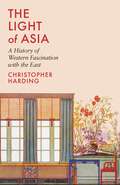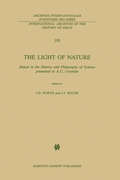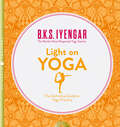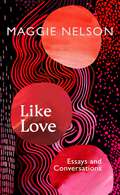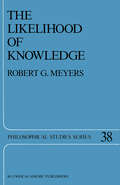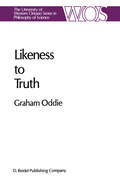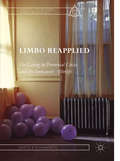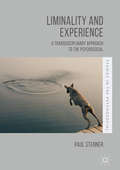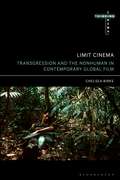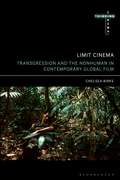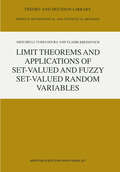- Table View
- List View
The Light of Asia: A History of Western Fascination with the East
by Christopher HardingThis rich and enjoyable book by the acclaimed author of Japan Story explores the many ways in which Asia has influenced Europe and North America over centuries of tangled, dynamic encountersFrom the time of the ancient Greeks onwards the West's relationship with Asia consisted for the most part of outrageous tales of strange beasts and monsters, of silk and spices shipped over vast distances and an uneasy sense of unknowable empires fantastically far away. By the twentieth century much of Asia might have come under Western rule after centuries of warfare, but its intellectual, artistic and spiritual influence was fighting back.The Light of Asia is a wonderfully varied and entertaining history of the many ways in which Asia has shaped European and North American culture over centuries of tangled, dynamic encounters, and the central importance of this vexed, often confused relationship. From Marco Polo onwards Asia has been both a source of genuine fascination and equally genuine failures of comprehension. China, India and Japan were all acknowledged to be both great civilizations and in crude ways seen as superseded by the West. From Chicago to Calcutta, and from antiquity to the new millennium, this is a rich, involving story of misunderstandings and sincere connection, of inspiration and falsehood, of geniuses, adventurers and con-men.Christopher Harding's captivating gallery of people and places celebrates Asia's impact on the West in all its variety.
The Light of Nature: Essays in the History and Philosophy of Science presented to A.C. Crombie (International Archives of the History of Ideas Archives internationales d'histoire des idées #110)
by J. D. North J. J. RocheThis volume of essays is meant as a tribute to Alistair Crombie by some of those who have studied with him. The occasion of its publication is his seven tieth birthday - 4 November 1985. Its contents are a reflection - or so it is hoped - of his own interests, and they indicate at the same time his influence on subjects he has pursued for some forty years. Born in Brisbane, Australia, Alistair Cameron Crombie took a first degree in zoology at the University of Melbourne in 1938, after which he moved to Je sus College, Cambridge. There he took a doctorate in the same subject (with a dissertation on population dynamics - foreshadowing a later interest in the history of Darwinism) in 1942. By this time he had taken up a research position with the Ministry of Agriculture and Fisheries in the Cambridge Zoological La boratory, a position he left in 1946, when he moved to a lectureship in the his tory and philosophy of science at University College, London. H. G. Andrewa ka and L. C. Birch, in a survey of the history of insect ecology (R. F. Smith, et al. , History of Entomology, 1973), recognise the importance of the works of Crombie (with which they couple the earlier work of Gause) as the principal sti mulus for the great interest taken in interspecific competition in the mid 194Os.
Light of Zen in the West: Incorporating 'The Supreme Doctrine' and 'The Realization of the Self'
by Graham RoothThis Centenary Commemorative Edition also includes two lesser known works Buddha and the Intuition of the Universal and Techniques of Timeless Realization. The volume is complemented by a detailed Glossary, an Index, an Original Foreword by Aldous Huxley (1955), an Original Preface by Swami Siddheswarananda (1955), and a Contemporary Foreword by Professor Asanga Tilakaratne. Benoits writings on the human predicament and the path to inner freedom were influenced by his studies in Zen Buddhism and psychoanalysis. There is, as well, an evident dialogue in Benoits writings between the Gurdjieff teaching and Zen, with insightful ideas about universal laws, inner work, the human machine, and work in life. The Supreme Doctrine and The Realization of the Self foreshadow contemporary transpersonal and integral psychology: through the re-integration of psychology and metaphysics, Benoit invites us to make our own journey toward spiritual transformation and the intuitive understanding of universal truths. This Centenary Commemorative Edition also includes two lesser known works Buddha and the Intuition of the Universal and Techniques of Timeless Realization. The volume is complemented by a detailed Glossary, an Index, an Original Foreword by Aldous Huxley (1955), an Original Preface by Swami Siddheswarananda (1955), and a Contemporary Foreword by Professor Asanga Tilakaratne.
Light of Zen in the West: Incorporating 'The Supreme Doctrine' and 'The Realization of the Self'
by Graham RoothThis Centenary Commemorative Edition also includes two lesser known works Buddha and the Intuition of the Universal and Techniques of Timeless Realization. The volume is complemented by a detailed Glossary, an Index, an Original Foreword by Aldous Huxley (1955), an Original Preface by Swami Siddheswarananda (1955), and a Contemporary Foreword by Professor Asanga Tilakaratne. Benoits writings on the human predicament and the path to inner freedom were influenced by his studies in Zen Buddhism and psychoanalysis. There is, as well, an evident dialogue in Benoits writings between the Gurdjieff teaching and Zen, with insightful ideas about universal laws, inner work, the human machine, and work in life. The Supreme Doctrine and The Realization of the Self foreshadow contemporary transpersonal and integral psychology: through the re-integration of psychology and metaphysics, Benoit invites us to make our own journey toward spiritual transformation and the intuitive understanding of universal truths. This Centenary Commemorative Edition also includes two lesser known works Buddha and the Intuition of the Universal and Techniques of Timeless Realization. The volume is complemented by a detailed Glossary, an Index, an Original Foreword by Aldous Huxley (1955), an Original Preface by Swami Siddheswarananda (1955), and a Contemporary Foreword by Professor Asanga Tilakaratne.
Light on Life: The Yoga Journey to Wholeness, Inner Peace and Ultimate Freedom (Iyengar Yoga Bks.)
by B.K.S. IyengarA must-have for anyone who practises yoga or is interested in the teachings of the East.B.K.S. Iyengar, whose teachings on yoga are followed throughout the world, reflects upon his lifetime's experience on the yoga path. The structure of the book follows the different aspects of that path (from Freedom Awaits, through The Physical Body, The Energy Body, The Mental Body, The Intellectual Body, The Divine Body to Living in Freedom) and provides a learning framework for yoga as well as an invaluable discourse on life.'Iyengar knows what the body needs, and he's introduced to the West the Easterner's best path to health and well-being' - TIME Magazine'Revelations from a lifetime of studying yoga' - The Washington Post 'Light on Life is rich in yoga philosophy and methodology. But unlike his previous writings, this new book is full of autobiographical anecdotes' - The New York Times 'Mr Iyengar reveals in Light on Life the 'heart of yoga' that he personally discovered through more than 70 years of disciplined, daily practice ... [including] the precise ways that yoga can transform our lives and help us live in harmony with the world around us' - Yoga Journal'The Michelangelo of yoga' - BBC TV
Light on Yoga: The Definitive Guide To Yoga Practice
by B. K. IyengarThe definitive work by B.K.S. Iyengar, the world’s most respected yoga teacher.
The Light that Failed: A Reckoning
by Ivan Krastev Stephen HolmesA landmark book that completely transforms our understanding of the crisis of liberalism, from two pre-eminent intellectualsWhy did the West, after winning the Cold War, lose its political balance?In the early 1990s, hopes for the eastward spread of liberal democracy were high. And yet the transformation of Eastern European countries gave rise to a bitter repudiation of liberalism itself, not only there but also back in the heartland of the West.In this brilliant work of political psychology, Ivan Krastev and Stephen Holmes argue that the supposed end of history turned out to be only the beginning of an Age of Imitation. Reckoning with the history of the last thirty years, they show that the most powerful force behind the wave of populist xenophobia that began in Eastern Europe stems from resentment at the post-1989 imperative to become Westernized.Through this prism, the Trump revolution represents an ironic fulfillment of the promise that the nations exiting from communist rule would come to resemble the United States. In a strange twist, Trump has elevated Putin's Russia and Orbán's Hungary into models for the United States.Written by two pre-eminent intellectuals bridging the East/West divide, The Light that Failed is a landmark book that sheds light on the extraordinary history of our Age of Imitation.
Light Through the Crack: The Meaning of Life in the Face of Adversity
by Avi SagiAn epidemic such as COVID-19 challenges life’s very order and meaning, interferes in our relations with others, and breaks apart our routine. It raises many questions in the realms of ethics, politics, theology, psychology, and beyond. Perhaps more than anything else, it prompts us to ponder: what does this encounter with widespread anguish and distress imply about the human self-perception as sovereign rulers of Earthly life?In this book, renowned thinker Avi Sagi explores the existential matters brought to the philosophical fore by the pandemic. He shows how we, when thrown into the terror of a crisis, carry the traditions, values, ideals, hopes, failures, and habits that constitute our lives, all shaping the way we grapple with questions seemingly resolved. We may then find that the crack that opens up at times of sorrow can also be a moment of discovery. Sagi analyzes various ways of confronting the crack now at the heart of our existence. What emerges is a clear normative statement: We are not only what we were but also what we can be, and we can create a world of meaning by standing together with others.
Like Fire Unbound
by Simon Petherick"A slow burn in its purest form - Petherick's fiery prose evokes a city smouldering with impassioned tensions that build towards an incendiary denouncement." - JAKE ARNOTT, AUTHOR OF THE LONG FIRMLondon is experiencing a heatwave in the summer of 2018. A disparate cast of characters are drawn together under the gaze of a mysterious mystic as they try their best to survive in the new contemporary capital, a city of changing rules, privatised streets, gig economies, fractured traditions.As the heat beats down upon them, day after day, they each attempt differing strategies to maintain their place, to protect their futures and somehow to forge a way through the challenge of the day. And reaching across the centuries is the story of Lily Cadyman, trying to survive in the heaving city: scraping by as maid to Thomas Farriner, whose bakery in Pudding Lane was the source of the first flames which caused the Great Fire of 1666.Like Fire Unbound is a novel about survival, where the city itself emerges as a character alongside all the others: essentially democratic, an egalitarian character like our cast who struggle to maintain their integrity in the early years of the twenty-first century, and a transformative year of the seventeenth.Like Fire Unbound weaves together the London of that terrifying summer of 1666 and the London of 2018, sweltering under a dizzying heat, building towards a seemingly inevitable crescendo.
Like Love: Essays and Conversations
by Maggie NelsonA CAREER-SPANNING COLLECTION OF INSPIRING, REVELROUS ESSAYS ABOUT ART AND ARTISTS'Like Love may be one of the most movingly specific, the most lovingly unruly celebrations of the ethics of friendship we have' Guardian'A polyphonic assemblage . . . graceful and aesthetic, deftly crossing boundaries and definitions, a concordant symphony' Irish TimesLike Love is a momentous, raucous collection of essays drawn from twenty years of Maggie Nelson's brilliant work. These profiles, reviews, remembrances, tributes and critical essays, as well as several conversations with friends and idols, bring to life Nelson's passion for dialogue and dissent. The range of subjects is wide - from Prince to Carolee Schneemann to Matthew Barney to Lhasa de Sela to Kara Walker - but certain themes recur: intergenerational exchange; love and friendship; feminist and queer issues, especially as they shift over time; subversion, transgression and perversity; the roles of the critic and language in relation to visual and performance arts; forces that feed or impede certain bodies and creators; and the fruits and follies of a life spent devoted to making.Arranged chronologically, Like Love shows the writing, thinking, feeling, reading, looking and conversing that occupied Nelson while writing iconic books such as Bluets and The Argonauts. As such, it is a portrait of a time, an anarchic party rich with wild guests, a window into Nelson's own development and a testament to the profound sustenance offered by art and artists.
Like A Thief In Broad Daylight: Power in the Era of Post-Humanity
by Slavoj ŽižekIn recent years, techno-scientific progress has started to utterly transform our world - changing it almost beyond recognition. In this extraordinary new book, renowned philosopher Slavoj Zizek turns to look at the brave new world of Big Tech, revealing how, with each new wave of innovation, we find ourselves moving closer and closer to a bizarrely literal realisation of Marx's prediction that 'all that is solid melts into air.' With the automation of work, the virtualisation of money, the dissipation of class communities and the rise of immaterial, intellectual labour, the global capitalist edifice is beginning to crumble, more quickly than ever before-and it is now on the verge of vanishing entirely.But what will come next? Against a backdrop of constant socio-technological upheaval, how could any kind of authentic change take place? In such a context, Zizek argues, there can be no great social triumph-lasting revolution has already come into the scene, like a thief in broad daylight, stealing into sight right before our ever eyes. What we must do now is wake up and see it. Urgent as ever, Like a Thief in Broad Daylight illuminates the new dangers as well as the radical possibilities thrown up by today's technological and scientific advances, and their electrifying implications for us all.
The Likelihood of Knowledge (Philosophical Studies Series #38)
by R.G. MeyersIt is convenient to divide the theory of knowledge into three sets of problems: 1. the nature of knowledge, certainty and related notions, 2. the nature and validi ty of the sources of knowledge, and 3. answers to skeptical arguments. The first set includes questions such as: What is it to know that something is the case? Does knowledge imply certainty? If not, how do they differ? What are the con ditions of knowledge? What is it to be justified in accepting something? The sec ond deals with the ways in which knowledge can be acquired. Traditional sources have included sources of premisses such as perception, memory, in trospection, innateness, revelation, testimony, and methods for drawing conclu sions such as induction and deduction, among others. Under this heading, philosophers have asked: Does innateness provide knowledge? Under what con ditions are beliefs from perception, testimony and memory justified? When does induction yield justified belief? Can induction itself be justified? Debates in this area have sometimes led philosophers to question sources (e. g. , revela tion, innateness) but usually the aim has been to clarify and increase our understanding of the notion of knowledge. The third class includes the peren nial puzzles taught to beginning students: the existence of other minds, the problem of the external world (along with questions about idealism and phenomenalism), and more general skeptical problems such as the problem of the criterion. These sets of questions are related.
Likeness to Truth (The Western Ontario Series in Philosophy of Science #30)
by G. OddieThe concept of likeness to truth, like that of truth itself, is fundamental to a realist conception of inquiry. To demonstrate this we need only make two rather modest aim of an inquiry, as an inquiry, is realist assumptions: the truth doctrine (that the the truth of some matter) and the progress doctrine (that one false theory may realise this aim better than another). Together these yield the conclusion that a false theory may be more truthlike, or closer to the truth, than another. It is the aim of this book to give a rigorous philosophical analysis of the concept of likeness to truth, and to examine the consequences, some of them no doubt surprising to those who have been unduly impressed by the (admittedly important) true/false dichotomy. Truthlikeness is not only a requirement of a particular philosophical outlook, it is as deeply embedded in common sense as the concept of truth. Everyone seems to be capable of grading various propositions, in different (hypothetical) situations, according to their closeness to the truth in those situations. And (if my experience is anything to go by) there is remarkable unanimity on these pretheoretical judge ments. This is not proof that there is a single coherent concept underlying these judgements. The whole point of engaging in philosophical analysis is to make this claim plausible.
Liking Ike: Eisenhower, Advertising, and the Rise of Celebrity Politics
by David Haven BlakeLiking Ike reveals the prominent role that celebrities and advertising agencies played in Dwight Eisenhower's presidency. Guided by Madison Avenue executives and television pioneers, Eisenhower cultivated famous supporters as a way of building the broad-based support that had eluded Republicans for twenty years. While we often think of John F. Kennedy and his Rat Pack entourage as the beginning of presidential glamour in the United States, celebrities from Ethel Merman and Irving Berlin to Jimmy Stewart and Helen Hayes regularly appeared in Eisenhower's campaigns. Ike's political career was so saturated with stardom that opponents from the right and left accused him of being a glamour candidate. Author David Haven Blake tells the story of how Madison Avenue executives strategically brought celebrities into the political process. Based on original interviews and long neglected archival materials, Liking Ike explores the changing dynamics of celebrity politics as Americans adjusted to the television age. By the 1920s, entertainers were routinely drawing publicity to their favorite candidates, but with the rise of television and mass advertising, political advisers began to professionalize the way that celebrities brought attention to presidential campaigns. In meetings, memos, and television scripts, they charted a strategy for leavening political programming with celebrity interviews, musical performances, and elaborate television spectaculars. Commentators worried about the seemingly superficial values that television had introduced to political campaigns, and writers, filmmakers, and fellow politicians criticized the influence of glamour and publicity. But despite these complaints, Eisenhower's legacy would live on in the subsequent careers of John F. Kennedy and Ronald Reagan-and, ultimately, provide a template for the presidential campaigns of Barack Obama, John McCain, Donald Trump, and Hillary Clinton.
Liking Ike: Eisenhower, Advertising, and the Rise of Celebrity Politics
by David Haven BlakeLiking Ike reveals the prominent role that celebrities and advertising agencies played in Dwight Eisenhower's presidency. Guided by Madison Avenue executives and television pioneers, Eisenhower cultivated famous supporters as a way of building the broad-based support that had eluded Republicans for twenty years. While we often think of John F. Kennedy and his Rat Pack entourage as the beginning of presidential glamour in the United States, celebrities from Ethel Merman and Irving Berlin to Jimmy Stewart and Helen Hayes regularly appeared in Eisenhower's campaigns. Ike's political career was so saturated with stardom that opponents from the right and left accused him of being a glamour candidate. Author David Haven Blake tells the story of how Madison Avenue executives strategically brought celebrities into the political process. Based on original interviews and long neglected archival materials, Liking Ike explores the changing dynamics of celebrity politics as Americans adjusted to the television age. By the 1920s, entertainers were routinely drawing publicity to their favorite candidates, but with the rise of television and mass advertising, political advisers began to professionalize the way that celebrities brought attention to presidential campaigns. In meetings, memos, and television scripts, they charted a strategy for leavening political programming with celebrity interviews, musical performances, and elaborate television spectaculars. Commentators worried about the seemingly superficial values that television had introduced to political campaigns, and writers, filmmakers, and fellow politicians criticized the influence of glamour and publicity. But despite these complaints, Eisenhower's legacy would live on in the subsequent careers of John F. Kennedy and Ronald Reagan-and, ultimately, provide a template for the presidential campaigns of Barack Obama, John McCain, Donald Trump, and Hillary Clinton.
The Lily of the Field and the Bird of the Air: Three Godly Discourses
by Søren Kierkegaard Bruce H. KirmmseIn the Sermon on the Mount, Jesus tells his followers to let go of earthly concerns by considering the lilies of the field and the birds of the air. Søren Kierkegaard's short masterpiece on this famous gospel passage draws out its vital lessons for readers in a rapidly modernizing and secularizing world. Trenchant, brilliant, and written in stunningly lucid prose, The Lily of the Field and the Bird of the Air (1849) is one of Kierkegaard's most important books. Presented here in a fresh new translation with an informative introduction, this profound yet accessible work serves as an ideal entrée to an essential modern thinker.The Lily of the Field and the Bird of the Air reveals a less familiar but deeply appealing side of the father of existentialism—unshorn of his complexity and subtlety, yet supremely approachable. As Kierkegaard later wrote of the book, "Without fighting with anybody and without speaking about myself, I said much of what needs to be said, but movingly, mildly, upliftingly."This masterful edition introduces one of Kierkegaard's most engaging and inspiring works to a new generation of readers.
The Lily of the Field and the Bird of the Air: Three Godly Discourses
by Søren Kierkegaard Bruce H. KirmmseIn the Sermon on the Mount, Jesus tells his followers to let go of earthly concerns by considering the lilies of the field and the birds of the air. Søren Kierkegaard's short masterpiece on this famous gospel passage draws out its vital lessons for readers in a rapidly modernizing and secularizing world. Trenchant, brilliant, and written in stunningly lucid prose, The Lily of the Field and the Bird of the Air (1849) is one of Kierkegaard's most important books. Presented here in a fresh new translation with an informative introduction, this profound yet accessible work serves as an ideal entrée to an essential modern thinker.The Lily of the Field and the Bird of the Air reveals a less familiar but deeply appealing side of the father of existentialism—unshorn of his complexity and subtlety, yet supremely approachable. As Kierkegaard later wrote of the book, "Without fighting with anybody and without speaking about myself, I said much of what needs to be said, but movingly, mildly, upliftingly."This masterful edition introduces one of Kierkegaard's most engaging and inspiring works to a new generation of readers.
Limbo Reapplied: On Living In Perennial Crisis And The Immanent Afterlife (Radical Theologies and Philosophies)
by Kristof K.P. VanhoutteThe observation that our world is signed by a lasting crisis is as much underwritten as it is questioned. This book offers a new and provocative thesis by taking recourse to the religious discourse of Limbo, and by investigating the temporal and spatial structures of crisis and modernity. Modernity reveals itself to be the state of perennial crisis, and we all live in an immanentized state of Limbo.
Limbo Reapplied (PDF)
by Kristof K.P. VanhoutteThe observation that our world is signed by a lasting crisis is as much underwritten as it is questioned. This book offers a new and provocative thesis by taking recourse to the religious discourse of Limbo, and by investigating the temporal and spatial structures of crisis and modernity. Modernity reveals itself to be the state of perennial crisis, and we all live in an immanentized state of Limbo.
Liminal Traces: Storying, Performing, And Embodying Postcoloniality (Transgressions #72)
by Devika Chawla Amardo RodriguezHome and exile have become key discussions in discourses of globalization, cosmopolitanism, postcolonialism, transnationalism, identity, and multiculturalism. These discourses can be expected to flourish in the future as an increasing number of multicultural scholars struggle with various kinds of displacements and the meaning of home that is thereby instantiated anew as we experience living in between cultures. This book sits in the intersection between cultural studies and performance studies. It seeks to break theoretical and empirical ground by reframing understandings of home and exile. Popular notions of exile forwarded by transnational and postcolonial scholars position home as a place of return and longing. While we believe that there are many truths in this position, we performatively seek emergent forms of displacement that are demanding new frameworks with which to enact meanings of home and exile. As Third World immigrant scholars in Western academe, we believe our move is vital in order to explore the experiences of persons, such as ourselves, who fall outside the models of displacement that have long constituted émigré writings. We define this move as a performative one because we experiment with different genres and voices to question and reproblematize existing understandings of knowledge frames. The genres we embody include performative writing, dialogue, autoethnography, essay form, personal narrative, and so on. Our goal is to address theories, stories, and pedagogies that speak to our tribulations in negotiating such intellectual displacements. This book can be an ideal supplementary text for courses in cultural studies as every chapter speaks in performative, reflexive, and storied ways to our own struggles to find real and theoretical homes. It will therefore have relevance to many departments in the humanities, including Communication Studies, English, Cultural Studies, Education, Anthropology, Sociology, and Women's Studies. In fact, this book serves the heuristic function of inspiring new research questions and demonstrating how a wide range of theories and research methods can be employed to enact discourses of home and exile.
Liminality and Experience: A Transdisciplinary Approach to the Psychosocial (Studies in the Psychosocial)
by Paul StennerThis book breathes new life into the study of liminal experiences of transition and transformation, or ‘becoming’. It brings fresh insight into affect and emotion, dream and imagination, and fabulation and symbolism by tracing their relation to experiences of liminality. The author proposes a distinctive theory of the relationship between psychology and the social sciences with much to share with the arts. Its premise is that psychosocial existence is not made of ‘stuff’ like building blocks, but of happenings and events in which the many elements that compose our lives are temporarily drawn together. The social is not a thing but a flow of processes, and our personal subjectivity is part of that flow, ‘selves’ being tightly interwoven with ‘others’. But there are breaks and ruptures in the flow, and during these liminal occasions our experience unravels and is rewoven. This book puts such moments at the core of the psychosocial research agenda. Of transdisciplinary scope, it will appeal beyond psychosocial studies and social psychology to all scholars interested in the interface between experience and social (dis)order.
Limit Cinema: Transgression and the Nonhuman in Contemporary Global Film (Thinking Cinema)
by Chelsea BirksLimit Cinema explores how contemporary global cinema represents the relationship between humans and nature. During the 21st century this relationship has become increasingly fraught due to proliferating social and environmental crises; recent films from Lars von Trier's Melancholia (2011) to Apichatpong Weerasethakul's Uncle Boonmee Who Can Recall His Past Lives (2010) address these problems by reflecting or renegotiating the terms of our engagement with the natural world. In this spirit, this book proposes a new film philosophy for the Anthropocene. It argues that certain contemporary films attempt to transgress the limits of human experience, and that such 'limit cinema' has the potential to help us rethink our relationship with nature. Posing a new and timely alternative to the process philosophies that have become orthodox in the fields of film philosophy and ecocriticism, Limit Cinema revitalizes the philosophy of Georges Bataille and puts forward a new reading of his notion of transgression in the context of our current environmental crisis. To that end, Limit Cinema brings Bataille into conversation with more recent discussions in the humanities that seek less anthropocentric modes of thought, including posthumanism, speculative realism, and other theories associated with the nonhuman turn. The problems at stake are global in scale, and the book therefore engages with cinema from a range of national and cultural contexts. From Ben Wheatley's psychological thrillers to Nettie Wild's eco-documentaries, limit cinema pushes against the boundaries of thought and encourages an ethical engagement with perspectives beyond the human.
Limit Cinema: Transgression and the Nonhuman in Contemporary Global Film (Thinking Cinema)
by Chelsea BirksLimit Cinema explores how contemporary global cinema represents the relationship between humans and nature. During the 21st century this relationship has become increasingly fraught due to proliferating social and environmental crises; recent films from Lars von Trier's Melancholia (2011) to Apichatpong Weerasethakul's Uncle Boonmee Who Can Recall His Past Lives (2010) address these problems by reflecting or renegotiating the terms of our engagement with the natural world. In this spirit, this book proposes a new film philosophy for the Anthropocene. It argues that certain contemporary films attempt to transgress the limits of human experience, and that such 'limit cinema' has the potential to help us rethink our relationship with nature. Posing a new and timely alternative to the process philosophies that have become orthodox in the fields of film philosophy and ecocriticism, Limit Cinema revitalizes the philosophy of Georges Bataille and puts forward a new reading of his notion of transgression in the context of our current environmental crisis. To that end, Limit Cinema brings Bataille into conversation with more recent discussions in the humanities that seek less anthropocentric modes of thought, including posthumanism, speculative realism, and other theories associated with the nonhuman turn. The problems at stake are global in scale, and the book therefore engages with cinema from a range of national and cultural contexts. From Ben Wheatley's psychological thrillers to Nettie Wild's eco-documentaries, limit cinema pushes against the boundaries of thought and encourages an ethical engagement with perspectives beyond the human.
Limit Theorems and Applications of Set-Valued and Fuzzy Set-Valued Random Variables (Theory and Decision Library B #43)
by Shoumei Li Y. Ogura V. KreinovichAfter the pioneering works by Robbins {1944, 1945) and Choquet (1955), the notation of a set-valued random variable (called a random closed set in literatures) was systematically introduced by Kendall {1974) and Matheron {1975). It is well known that the theory of set-valued random variables is a natural extension of that of general real-valued random variables or random vectors. However, owing to the topological structure of the space of closed sets and special features of set-theoretic operations ( cf. Beer [27]), set-valued random variables have many special properties. This gives new meanings for the classical probability theory. As a result of the development in this area in the past more than 30 years, the theory of set-valued random variables with many applications has become one of new and active branches in probability theory. In practice also, we are often faced with random experiments whose outcomes are not numbers but are expressed in inexact linguistic terms.
